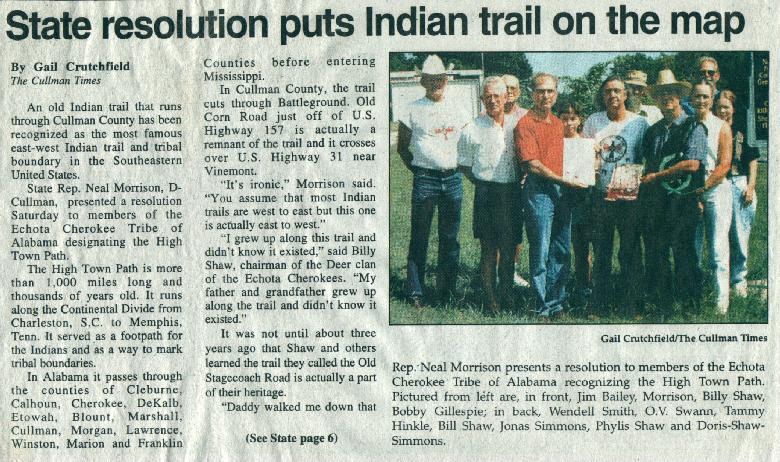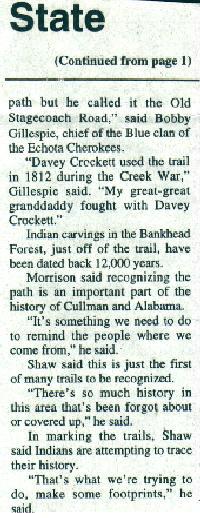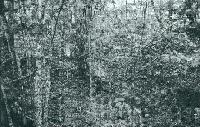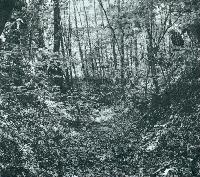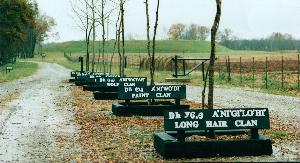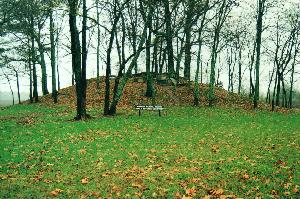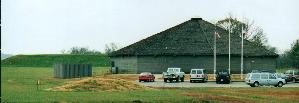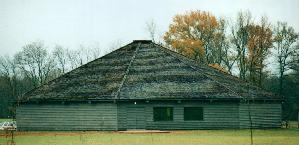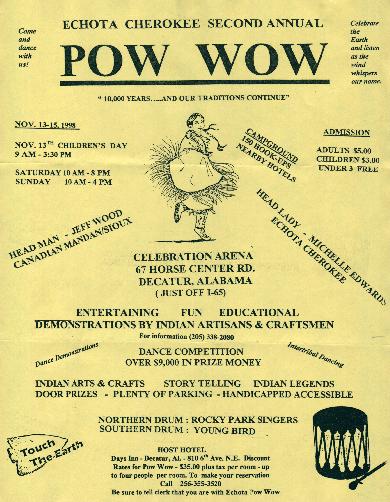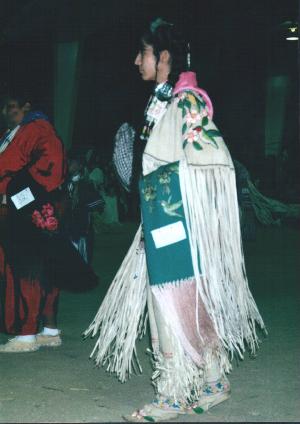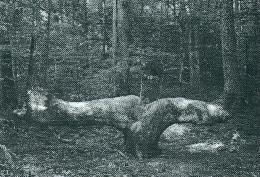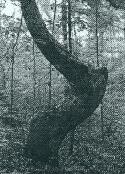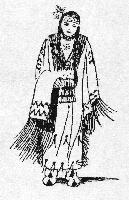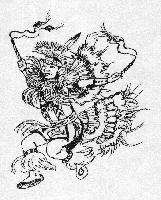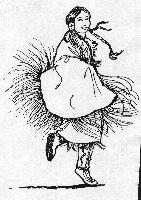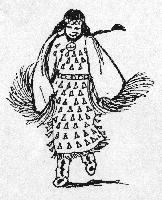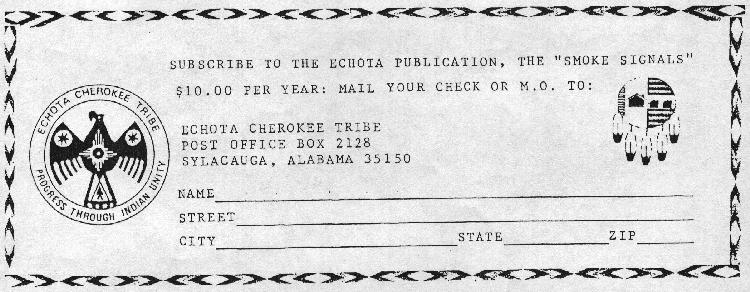WHAT IS A POW WOW?
A Pow Wow is a gathering which was originally held once or twice a year in a location central to each Nation. The tribes traveled great distances, for these were important gatherings for social and political reasons. Feats of bravery and outstanding accomplishments were honored. Weddings were performed, births were celebrated and deaths were mourned. Meetings were held among the tribal elders, and decisions were reached which would affect the lives during the coming year.
There was much feasting and dancing but, originally, only the
warriors danced. Their dances told the stories of their victories; both in a battle and in the hunt, and of their accomplishments.
The words "Pow Wow" are the European adaptation of the Algonquin
term "Pau Wau", which referred to the tribal medicine people and spiritual leaders. White men expanded the term to mean the entire gathering of tribes, and this was gradually accepted by the Nations.
There are different types of gatherings which call themselves "Pow Wows"; some are, and some are not. There are very large events which are truly arts and crafts shows with Native exhibition dancers. There are small, local one-day events which are social gatherings. It is a real Pow Wow, but not on the grand scale I am about to describe. Then there are 3-day events which draw thousands of spectators with hundreds of dancers and many drums from all over the United States, Canada, and Mexico. The participants compete for prize money, and many tribes are represented. This is the inter-tribal competition Pow Wow which is glorious and exciting to watch, and which began in the early 1900's. Until that time, dances were performed only by elite warrior societies for the benefit of tribal elders and tribal dignitaries.
The dancing often goes into the small hours of the morning. Dancers are judged on the authenticity of their regalia and dance movements, the position and movement of their heads, bodies and feet, how they use the ceremonial tools they carry in their hands, and how their dancing begins, flows and ends with the beat of the drum.

THE POW WOW DRUM
The drum and its singers are the heartbeat of all the Nations, and certainly of a Pow Wow.
There are a least two host drums. A Northern, a Southern, and sometimes
a Canadian, and they are responsible for keeping the competition flowing
in an uninterrupted manner with no gaps in music. Northern and Southern
do not refer to the part of the country the drum comes from., but rather
to the type of music and songs they play. One is high-pitched and
faster; the other is lower in pitch and slower.
YOU CAN JOIN IN, TOO:
Several dances are called often to give the
competing dancers a break, and to encourage spectators to come into the
arena, meet new friends and feel the heart of the drum. Women should
wear a shawl, or scarf, or even a sweater across their shoulders as a
sign of respect of the traditions of the arena and the drum. You should
relax, let your feet do their own thing, and enjoy the fellowship.
Children are welcome to dance as well. There are several of these
dances ... The Inter-Tribal, The Round Dance, The Friendship Dance and The
Social Dance or Two Step.
|
POW WOW PROTOCOL
When you attend a Pow Wow, it is important to remember that you are a guest, and an observer of ancient ceremonies and traditions that have survived every possible adversity.
Here are things you need to know for proper behavior.
- Under no circumstances is alcohol or drugs allowed on Pow Wow grounds.
- Once the dance arena has been blessed with sage and prayer, it becomes spiritual ground.
Do no walk across the arena and don't allow your children to run into the arena. The bales
of hay and/or chairs near the dance arena are for the dancers and relatives. As a
spectator, do not sit in this area and do not permit your children to do so.
- Don't take pictures at random - either still shots or video. Some Pow Wows do not permit
photography, others allow only limited photography and some do not mind if you take
photos. If you see a dancer who is especially striking, ask if you may take a picture
after he leaves the arena. It would be a courtesy to take his name and address
and send him a print of the photo.
- A dancer's clothing is REGALIA - not a costume - and is a prized possession. It takes
years to collect the items until the regalia is complete, and this involves no small
expense. Do not ever touch a dancer's regalia without permission. Honor it, and the person
wearing it.
- Finally, put aside the Hollywood image of what an "Indian" looks like. Natives come in all
sizes, shapes and colors. From the milky skinned blue-eyed blond and the green-eyed
redhead to the dark brown and black, they are all Native in their heritage, blood and
heart. Look, learn, and enjoy.
THE GRAND ENTRY
All dancers enter the arena from the East as the place on the Medicine Wheel of new beginnings, of new birth and re-birth, and of awakenings. The Grand Entry is no exception.
Everyone will be asked to stand during the Grand Entry and men are asked to remove any head gear
unless it carries and eagle feather.
Leading the Grand Entry is the Eagle Staff, followed by the American Flag, the POW-MIA Flag, and the Tribal Flag of the Pow Wow host. Being a flag bearer is a great honor not taken lightly by either the Pow Wow Committee or the persons selected.
The Head Dancers in each division lead title holders from various Native pageants and events next in the procession. Next enter the men dancers and then the women dancers. The procession winds around the arena in the direction of the sun with the dancers showing off their regalia and footwork to the spectators indicating that they are ready to
begin.
After all dancers have entered the arena and made a complete circle,
there is a Flag Song followed by an invocation blessing the gathering. Following the invocation, the Eagle Staff and all flags are positioned either in the center of the arena, or at the announcer's booth. Once the Staff and flags are set to rest, the Pow Wow is ready to begin...
NOW YOU CAN SIT DOWN.
|
MEN'S COMPETITIVE DANCING:
- Traditional Dance ... These dances are as ancient as the Native peoples themselves. The dancers represent warriors as they prepare for the hunt and for battle, and as they return to dance the stories of their adventures. The body movements must be authentic for the tribe and region, the basic regalia must be authentic, and the dance steps must be executed with the rhythm of the drum. The Traditional Dance is divided into two categories: Northern Traditional and Southern Straight. This is no indicator of the part of the country the dancer comes from, but a
style of dancing and regalia.
- Northern Traditional regalia has as its basic components a breech cloth, a breastplate, a choker, a belt, wide wrist cuffs, arm bands, moccasins, and appropriate decorations either on the head or in the hair. Regalia may also include leggings, a long-sleeved ribbon shirt, and a single bustle of feathers. In the hands are carried a war shield, dance staff, a feather fan, a war weapon, and many times a dream catcher or medicine wheel. This dance is more physically active than the Southern Straight.
- Southern Straight regalia is similar in many ways to Northern Traditional. The most distinctive and easily identified item of the Southern Straight regalia is a very long trailer which goes down the dancer's back to the ground. Usually made of otter fur, and called a "drag", this article of clothing is decorated with beadwork and other items which have a special significance to the dancer. This dance is very tightly controlled and elegant.
- The Grass Dance: The Grass Dance is ancient, has many names from Nation to Nation, and different stories about its origins and purpose. One version tells that the streamers of grass were hung from the waist, and the grass dancers were called in to tamp down the tall grass before
a village or camp site was set up. The Grass Dance is the most beautiful and graceful of all the men's dances with emphasis on long, fluid body motions to emulate waving prairie grass. The mark of an expert Grass Dancer is his ability to keep his head nodding from side to side, or up and down, in time to the drum beat in order to keep the feathers resting on his roach headdress constantly spinning. The Grass Dancer's regalia is made up of an ornate yoke which slips over the head and rests on the shoulders, a belt, beaded moccasins, beaded wrist cuffs, a bandana around his head topped with a porcupine roach. From the shoulders, chest, wrist and waist hang very long strands of yarn in colors of choice.
- The Fancy Dance: The men's Fancy Dance evolved at the same time that Pow Wows were opened to the public and competition dancing began. The Fancy Dance is said to have originated in Oklahoma where Native dancers were asked to make their regalia more colorful and exciting for the white spectators. Thus, the brilliant feathers of many colors, bearing long streamers which fly in the wind, decorations of sequins, mirrors and other decorations were introduced. The Fancy Dance is an original, free-form dance which shows off the athletic ability, acrobatics and endurance of the dancer as it features leaps, spins and fast footwork, all in time to the drum. The drum will often get faster and faster, stopping and starting without warning. The dancer must keep up with the drum's rhythms, stops and starts, or lose points in the competition.
|
WOMEN'S COMPETITIVE DANCES
- Women's Traditional Dance: As with the men, the Women's
Traditional Dance is as old as the history of Native dancing. In ancient
days, women danced in a circle at the outer edge of the arena so they
could keep watch over the safety of the village while the men were
otherwise occupied. There are two types of regalia and two types of
dance steps ... Northern and Southern. The Northern style of dance is
performed in one spot with the woman's body doing all the work, and her
feet shifting in place without actually traveling around the arena. The
Southern style moves around the arena in a clockwise motion, in a slow,
tightly controlled majestic manner.
There are also two types of regalia ... Buckskin and Cloth. The
Buckskin regalia is heavily beaded in elaborate patterns and has yards
of flowing fringe from the arms and hem. This fringe is said to
represent the continuous flow of a waterfall with its life-giving water
and energy. The hair is heavily decorated and usually has hair wraps of
fur or heavily beaded hair ties. All manner of fine jewelry is worn in
the ears, around the neck, and on the fingers. The dancer wears beaded
moccasins with matching leggings, a beaded or silver belt, a heavily
fringed shawl folded over one arm and a feather fan. Cloth regalia in
the southeast is separated into three different types ... Western Cloth,
Cherokee and Creek Cloth regalia. Western Cloth is traditionally made of
trade cloth and is decorated with elk teeth, coins, cowrie shells and
other shells. Many times it is also decorated with ribbon work, fine
embroider or floral appliques depending on the woman's tribal customs.
The Cherokee Cloth regalia is made of calico material and includes a
knife on the back of her regalia, while the Creek Cloth regalia is
decorated with an apron, rows of ruffles and no knives. Another
distinction of the Cherokee Cloth regalia is The Trail of Tears Dress or
Tear Dress ... so called because when the women were forced to march, they
were not permitted to bring their knives and therefore had to rip the
decorative designs and attach to their dresses. The remaining
accessories of the Traditional Cloth regalia remains much the same as
the Buckskin regalia.
- The Jingle Dress Dance: In the 1920's, the Jingle Dress was being
used in competitive dancing. The dress itself is knee length, made of
fabric and is covered from shoulder to hem with hundreds of "jingles" -
cones made from the metal lids of snuff cans. Beaded or silver concho
belts, matching and beaded moccasins and leggings, a scarf at the neck
and a fan made of feathers completes the regalia. The dance itself is
fast ... not only must the Jingle Dress Dancer keep the rhythm of the
drum, she must also keep the rhythm of the jingles, stopping when the
drum stops with both feet on the ground.
- The Fancy Shawl Dance: This is a woman's dance which began in the
early 1930's, making it a new tradition in competition dancing. The
dresses are traditionally made of satin or taffeta, are knee length and
are worn with heavily beaded and matching moccasins and leggings,.
Elaborate beadwork is also worn in the hair and on yokes placed over the
lightweight dresses. Most important is the elegant shawl with its long,
flowing fringe which is opened and closed often during the course of the
dance. The steps of the dance are all original, fast and athletic with
the focus being on spins and twirls with the shawls. An expert Fancy
Shawl Dancer appears to never tough the ground as her footwork is so
light and fast, and the motion of her body so fluid. Again, her feet
must move in rhythm with the tempo of the drum, stopping and starting
when it does, and ending her dance with both feet on the ground and her
arms at her side.
|
